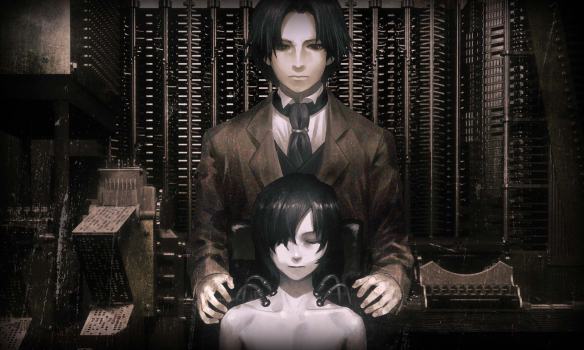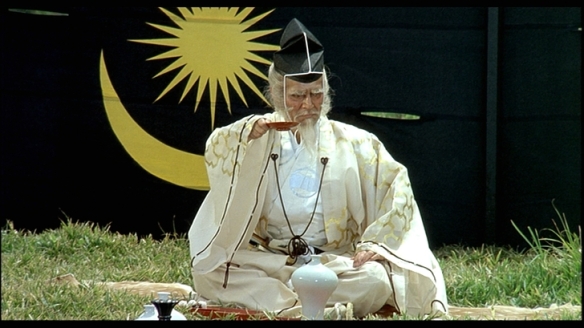
Information wants to be free. Despite the public failure of Dr Frankenstein’s experiments with reanimated cadavers, his technology spreads like wildfire. When the mathematician Charles Babbage invents “necroware” that can turn a corpse into a servant, the British Empire is transformed through an entire underclass of zombie workers. John Watson, a young doctor, is recruited by “M” from the secret service to track down Frankenstein’s missing papers, in the hope that he can unravel the last mystery – how to bring back a human soul along with a body…
Satoshi Ito was the darling of Japanese science fiction in the early 21st century. Born in 1974, he shot to fame in 2007 with his novel Genocidal Organ, in which terrorists get their hands on nuclear weapons, plunging the free world into a downward spiral of restrictive surveillance. It was voted the book of the decade by Japanese fandom, and swiftly led to Ito’s work-for-hire novelising the video game Metal Gear Solid 4: Guns of the Patriots. His next original splash was Harmony, which concentrated on the hunger strikers who protested against a self-proclaimed utopia. But only two years after his debut novel, Ito was already mortally ill, repeatedly hospitalised with cancer. His obsession with medical technology in Harmony hence took on a new, grim relevance, as did the handful of pages from his last idea… left behind after his untimely death, aged just 34, in 2009.
Empire of Corpses was lightning in a bottle – an industrial revolution founded not on slave labour, but on reanimated corpses, pushed every post-colonial button in modern fiction, along with a “Great Game” stand-off between British and Russian agents in the killing grounds of the Middle East. It had everything: espionage, exotic locations, steampunk stylings, and a league of extraordinary gentlemen ripped from the pages of history and adventure – we see the newly minted Dr Watson receive the injuries in Afghanistan that he would later grumble about to a more famous sleuthing companion. And he’s only the first of a whole host of figures who pile into the narrative like a who’s-who of the 19th century, including the Brothers Karamazov (working undercover for the Tsar), Thomas Edison and Ulysses S. Grant.
Ito’s publishers wouldn’t let it die. They commissioned his friend Toh Enjoe, a very different novelist, to finish the work in progress, and the collaboration beyond the grave would go on to win a Seiun Award (Japan’s Hugo) in 2013. All three of Ito’s novel-length works went into production as animated features – partly, one suspects because of his undeniable popularity, although a cynic might suggest that the best possible original creator in the eyes of an anime producer is one who is too dead to answer back. Empire of Corpses was the first of the three to reach cinemas – rumours persist that it was rushed through in order to take a slot vacated by a more troubled production. That, at least would explain some of its problems, since it looks fantastic, sounds like a dream come true, but ultimately shambles like creature born from several great ideas, sewn together but not quite quickened with the spark of life.
It’s difficult to know where the problem lies for Empire of Corpses – right from its publication in novel form, there was always the concern that Toh Enjoe took the narrative far from the original creator’s intentions. It starts so well, but you can almost feel the moment 20 minutes in when the original pages ran out, and Toh started to wing it. His rescue job on Ito’s notes won a Seiun Award in Japan, although we’ll never know how much of that was a sympathy vote for the dead co-author. Three further writers are credited with bringing the film to the screen, and it’s they, we might assume, who sat around brainstorming and decided that what the main female lead Hadaly Lilith needed was a really big pair of boobs. Her pneumatic shuffling through the movie detracts from a storyline that otherwise takes itself very seriously indeed, but which lumbers uneasily from fiercely argued anti-colonialism, to a subtle gay romance, to a somewhat illogical zombie drama (suddenly, biting people makes them undead), to the origin story for an entirely different series, only revealed in a post-credits sting. The final act, in particular, gets bogged down in a Japanese interlude and an explosion-happy finale, a big finish seemingly hobbled by the twin golems of budget and time.
Jonathan Clements is the author of Anime: A History. This article first appeared in Geeky Monkey #12, 2016.

 As part of the research for the PSYCHO-PASS anime film, director Naoyoshi Shiotani trained with Tamura Tactical Gear, a company that offers military re-enactments. “I asked them what was never done in movies,” he recalls, “and they told me that hardly anyone ever shows the wounded getting treated. I thought that was a brilliant idea.” It’s precisely the sort of attention to counter-intuitive detail that has made PSYCHO-PASS one of the anime hits of recent memory.
As part of the research for the PSYCHO-PASS anime film, director Naoyoshi Shiotani trained with Tamura Tactical Gear, a company that offers military re-enactments. “I asked them what was never done in movies,” he recalls, “and they told me that hardly anyone ever shows the wounded getting treated. I thought that was a brilliant idea.” It’s precisely the sort of attention to counter-intuitive detail that has made PSYCHO-PASS one of the anime hits of recent memory.




 To Paris in June, where the local branch of the auction house Sotheby’s held a sale of 260 pieces of comics artwork, including samples from the likes of Jim Lee, Hugo Pratt and Uderzo, with a total sale value of €1.3 million.
To Paris in June, where the local branch of the auction house Sotheby’s held a sale of 260 pieces of comics artwork, including samples from the likes of Jim Lee, Hugo Pratt and Uderzo, with a total sale value of €1.3 million. Most surprising was a single head-shot of Dragon Ball’s Son Goku, drawn by Akira Toriyama, which went for €15,000, five times the estimated price. Toriyama is still happily alive, and is presumably cackling to himself in his studio as he knocks out another hundred such sketches to put on eBay. One suspects that Chinese capital is at work here, bidding up the value among people who have read the manga in Mandarin.
Most surprising was a single head-shot of Dragon Ball’s Son Goku, drawn by Akira Toriyama, which went for €15,000, five times the estimated price. Toriyama is still happily alive, and is presumably cackling to himself in his studio as he knocks out another hundred such sketches to put on eBay. One suspects that Chinese capital is at work here, bidding up the value among people who have read the manga in Mandarin.